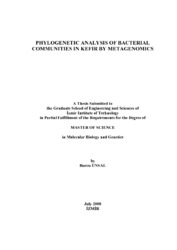Please use this identifier to cite or link to this item:
https://hdl.handle.net/11147/3925Full metadata record
| DC Field | Value | Language |
|---|---|---|
| dc.contributor.advisor | Arslanoğlu, Alper | en |
| dc.contributor.author | Ünsal, Burcu | - |
| dc.date.accessioned | 2014-07-22T13:52:42Z | - |
| dc.date.available | 2014-07-22T13:52:42Z | - |
| dc.date.issued | 2008 | en |
| dc.identifier.uri | http://hdl.handle.net/11147/3925 | - |
| dc.description | Thesis (Master)--Izmir Institute of Technology, Molecular Biology and Genetics, Izmir, 2008 | en |
| dc.description | Includes bibliographical references (leaves: 66-73) | en |
| dc.description | Text in English; Abstract: Turkish and English | en |
| dc.description | xiv, 80 leaves | en |
| dc.description.abstract | Kefir is a traditional fermented milk beverage which is produced by adding kefir grains into milk and is allowed for fermentation. Grains contain vital complex flora of microorganisms (bacteria and yeast) that live in harmony. Since health and food safety of fermented milk products is important, population structure of food-type microbes involve in fermentation should be known very well. Rapid determination of kefir bacterial composition may accelerate the determination of food quality and also may facilitate specification of bioactive products that obtain from kefir. The goal of this thesis was to analysis the genomic structure of bacterial communities of the fermented kefir drink and grains by both culture-dependent and culture-independent methods (metagenomic approach). Total Genomic DNA was purified from each analysis methods and the partial small subunits of 16S rDNA were amplified by a pair of universal bacterial primers. 16S rDNAs fragments were cloned and then sequenced. The vast quantities of data were screened in NCBI database by BLASTN program according to similarity scores with related sequences. 7 different bacteria were identified to species level composed of Lactococcus lactis subsp. lactis , Lactobacillus kefiranofaciens, Lactobacillus helveticus, Acetobacter lovaniensis, Acetobacter syzygii, Leuconostoc mesenteroides, Enterococcus faecium and 1 bacteria to genus level named Lactobacillus kefiri or parabucheri. The results of this study showed that the combination of both methods is more efficient to identify high percentage of species than using only one of them. Finally, phylogenetic relationships among identified species inferred from partial 16S rRNAs gene sequencing were determined by Neighbor-joining algorithm. | en |
| dc.language.iso | en | en_US |
| dc.publisher | Izmir Institute of Technology | en |
| dc.rights | info:eu-repo/semantics/openAccess | en_US |
| dc.subject.lcc | QR151. U59 2008 | en |
| dc.subject.lcsh | Fermentation | en |
| dc.subject.lcsh | Fermented milk | en |
| dc.subject.lcsh | Cladistic analysis | en |
| dc.subject.lcsh | Kefir | en |
| dc.title | Phylogenetic analysis of bacterial communities in kefir by metagenomics | en_US |
| dc.type | Master Thesis | en_US |
| dc.institutionauthor | Ünsal, Burcu | - |
| dc.department | Thesis (Master)--İzmir Institute of Technology, Molecular Biology and Genetics | en_US |
| dc.relation.publicationcategory | Tez | en_US |
| item.openairecristype | http://purl.org/coar/resource_type/c_18cf | - |
| item.cerifentitytype | Publications | - |
| item.fulltext | With Fulltext | - |
| item.languageiso639-1 | en | - |
| item.grantfulltext | open | - |
| item.openairetype | Master Thesis | - |
| Appears in Collections: | Master Degree / Yüksek Lisans Tezleri | |
Files in This Item:
| File | Description | Size | Format | |
|---|---|---|---|---|
| T000678.pdf | MasterThesis | 843.58 kB | Adobe PDF |  View/Open |
CORE Recommender
Page view(s)
100
checked on Apr 15, 2024
Download(s)
122
checked on Apr 15, 2024
Google ScholarTM
Check
Items in GCRIS Repository are protected by copyright, with all rights reserved, unless otherwise indicated.